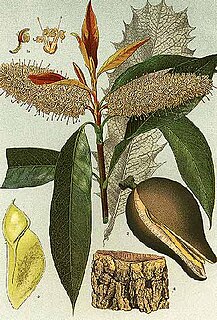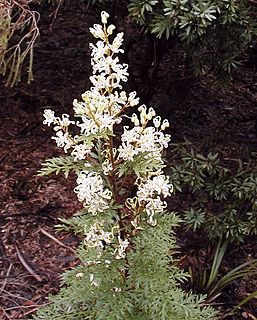
The Lamniformes are an order of sharks commonly known as mackerel sharks. It includes some of the most familiar species of sharks, such as the great white, as well as more unusual representatives, such as the goblin shark and megamouth shark.

The Restionaceae, also called restiads and restios, are a family of flowering plants native to the Southern Hemisphere; they vary from a few centimeters to 3 meters in height. Following the APG IV (2016): the family now includes the former families Anarthriaceae, Centrolepidaceae and Lyginiaceae, and as such includes 51 genera with 572 known species. Based on evidence from fossil pollens, the Restionaceae likely originated more than 65 million years ago during the Late Cretaceous period, when the southern continents were still part of Gondwana.

Xylomelum is a genus of six species of flowering plants, often commonly known as woody pears, in the family Proteaceae and are endemic to Australia. Plants in this genus are tall shrubs or small trees with leaves arranged in opposite pairs, relatively small flowers arranged in spike-like groups, and the fruit a woody, more or less pear-shaped follicle.

The family Oedemeridae is a cosmopolitan group of beetles commonly known as false blister beetles, though some recent authors have coined the name pollen-feeding beetles. There are some 100 genera and 1,500 species in the family, mostly associated with rotting wood as larvae, though adults are quite common on flowers. The family was erected by Pierre André Latreille in 1810.

Brunonia australis, commonly known as the blue pincushion or native cornflower, is a perennial or annual herb that grows widely across Australia. It is found in woodlands, open forest and sand plains. In Cronquist's classification scheme it was the sole member of the monogeneric plant family Brunoniaceae. The APG II system moved it into Goodeniaceae, with which it shares the stylar pollen-cup, or indusium, a character confined to these taxa. Brunonia is unique among Goodeniaceae in its radially symmetric flowers, the superior ovary and the absence of endosperm in the seeds.

Dryandra subg. Hemiclidia is an obsolete plant taxon that encompassed material that is now included in Banksia. Published at genus rank as Hemiclidia by Robert Brown in 1830, it was set aside by George Bentham in 1870, but reinstated at subgenus rank by Alex George in 1996. In 2007, all Dryandra species were transferred into Banksia at series rank, and the infrageneric Dryandra taxa, including D. subg. Hemiclidia, were set aside.

Bellendena montana, commonly known as mountain rocket, is a species of low-growing multi-stemmed shrub in the plant family Proteaceae. It is endemic to high-altitude subalpine and alpine regions in Tasmania, Australia. The prominent white flower spikes appear over summer, followed by small bright red or yellow fruit in late summer and autumn.

Acidonia microcarpa is a species of shrub in the plant family Proteaceae. It is the only species in the genus Acidonia. It is endemic to the south coast of the Southwest Botanic Province of Western Australia.

Isopogon ceratophyllus, commonly known as the horny cone-bush or wild Irishman, is a plant of the family Proteaceae that is endemic to the coast in Victoria, South Australia and on the Furneaux Group of islands in Tasmania. It is a small woody shrub that grows to 100 cm high with prickly foliage. It is extremely sensitive to dieback from the pathogen Phytophthora cinnamomi
Hypolaena is a plant genus in the family Restionaceae, described as a genus in 1810. The entire genus is endemic to Australia.

Grevillea ilicifolia, commonly known as holly grevillea, is a species of the plant genus Grevillea. It is a shrub of variable form, growing to between 0.3 and 2 metres in height and 3 metres wide. Typically, leaves are lobed and holly like, but may also be unlobed. The flowers have perianths that have a base that is cream to green grading to grey-mauve. Styles may be pink, red, orange or yellow. The main flowering period in the species' native range is September to November.

Persoonia laurina, commonly known as the laurel-leaved or laurel geebung, is a shrub of the family Proteaceae native to central New South Wales in eastern Australia. Found in sclerophyll forest, it grows to a height of 2 metres. The yellow flowers appear in late spring.

Lomatia silaifolia, commonly known as crinkle bush or parsley fern, is a plant of the family, Proteaceae native to eastern Australia. Naturally found in open forest, it grows as a small shrub 1–2 m high with highly pinnate leaves reminiscent of parsley. The white inflorescences appear in summer.

Petrophile pedunculata, commonly known as conesticks, is a species of flowering plant in the family Proteaceae and is endemic to New South Wales. It has divided leaves with needle-shaped pinnae and oval heads of sparsely hairy yellow or cream-coloured flowers, the heads on a peduncle 10–15 mm (0.39–0.59 in) long.

Orites revolutus , also known as narrow-leaf orites, is a Tasmanian endemic plant species in the family Proteaceae. Scottish botanist Robert Brown formally described the species in Transactions of the Linnean Society of London in 1810 from a specimen collected at Lake St Clair. Abundant in alpine and subalpine heath, it is a small to medium shrub 0.5 to 1.5 m tall, with relatively small, blunt leaves with strongly revolute margins. The white flowers grow on terminal spikes during summer. Being proteaceaous, O. revolutus is likely to provide a substantial food source for nectivorous animal species within its range.

Astephanus is a genus of flowering plants in the family Apocynaceae, first described as a genus in 1810.

Hakea elliptica, commonly known as the oval-leaf hakea, is a shrub in the family Proteacea and is endemic to Western Australia. A fast growing adaptable species with ornamental wavy leaves, golden bronze new growth and an abundance of showy white flowers. A good wildlife habitat due to its dense form with foliage to ground level.

Isopogon longifolius is a small shrub in the family Proteaceae that is endemic to the southwest of Western Australia.
Oreobolus is a genus of flowering plants in the family Cyperaceae. The genus has a circumpacific distribution.

Franklandia fucifolia, or lanoline bush, is native to the south-west of Western Australia. It is a species in the Franklandia genus of the Proteaceae family.


















